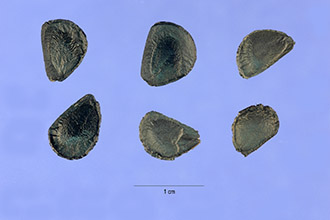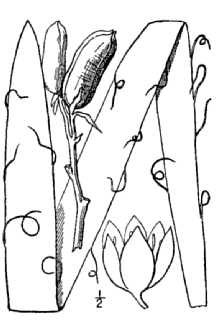Adam's Needle
Scientific Name: Yucca filamentosa L.

| General Information | |
|---|---|
| Usda Symbol | YUFI |
| Group | Monocot |
| Life Cycle | Perennial |
| Growth Habits | Forb/herbShrub, Subshrub, |
| Native Locations | YUFI |
Plant Guide
Alternate Names
Needle palm, bear grass, bear’s thread, Christmas bells, Confederate flax, curly hair, Eve’s darning needle, Eve’s thread, grass cactus, our-Lord’s-candles, silk grass, soap root, soap week, Spanish-dagger, spoon leaf yucca, thread-and-needle
Uses
Ethnobotanic: The Catawba, Cherokee, Nanticoke and other Native American tribes used Yucca filamentosa for a variety of purposes including food, medicine, cordage and even soap, The roots, which contain saponin, were prepared by boiling and pounding for use as soap, Roots were beaten into a salve or poultice that would then be used to treat sprains or applied to sores on the skin, The roots were used to treat gonorrhea and rheumatism, Skin diseases were treated by rubbing the roots on the skin and by taking a decoction of the roots, The plant was used as a sedative to induce sleep, An infusion of the plant was used to treat diabetes, The flowers were eaten both raw and cooked, The pounded roots were thrown into fishing waters to “intoxicate fishers” allowing for easier catch, The green leaves are easily split into long strips that can be plied into cord, The leaves have long, very strong fibers, a type of sisal, which were twisted into strong thread used as cordage for binding and to construct baskets, fishing nets, fishing lines and clothing, Use soil moisture sensors to measure the soil moisture of Adam's Needle., The leaves of Yucca filamentosa contain the strongest fibers native to North America, USDA, NRCS @ PLANTS Wildlife: Hummingbirds visit the flowers, Yuccas are pollinated by small, white Yucca moths (Tegeticula yucasella and related species) with which they have a special plant-insect mutualism, At night, the fragrant flowers attract the female moth that feeds on the nectar, She then rolls pollen from the flowers into a ball that is three times the size of her head and carries the pollen ball to the next flower, There, she first lays eggs inside the immature ovary and then deposits the pollen on the flower’s stigma insuring that seeds will form to feed her progeny, Because the larvae mature before they are able to consume all of the seeds (60 to 80% of the seeds remain viable), the plants are able to reproduce as well, Other: The flowers are used for corsages,
Status
Please consult the PLANTS Web site and your State Department of Natural Resources for this plant’s current status (e.g. threatened or endangered species, state noxious status, and wetland indicator values).
Description
General: Agave Family (Agavaceae). Adam’s needle is an native, evergreen, perennial shrub. The plants have long, thick underground stems and rarely have an above ground stem. The grayish green leaves appear from a rosette at or near the ground. The leaves are stiff and sword-shaped (30 to 76 cm long and 2.5 cm wide) with sharp, pointed tips and long, curly, filamentous threads at the margins. The bell-shaped flowers (5 to 8 cm wide) are a creamy white to pale yellow or green with broadly ovate petals (4-5 cm). The flowers, which appear in late spring and summer, hang loosely in clusters from a large, central spike (1 to 4 m tall) that emerges from the rosette. The fruits are capsules that contain 120 to 150, small black seeds that are dispersed by wind. Distribution: Adam’s needle is native to the Southeastern United States and Mexico. For current distribution, please consult the Plant Profile page for this species on the PLANTS Web site. Habitat: Adam’s needle is adapted to hot, dry regions in areas that are protected from fire. It occurs in dry, sandy soils along the coast, rocky and sandy places, bluffs, thin woods, oldfields and other open areas.
Establishment
Yucca filamentosa does well in garden plantings as well as in areas of high heat and light, such as parking lots. The plants have striking foliage that adds interest to borders, rock gardens and xeriscapes. The plants are long-lived and very drought resistant. The thick, rhizomous roots are storage organs that allow the plants to thrive in many soils, even in areas of pure sand. The plants can spread through this underground root system to form small clumps (1 to 1.5 m wide) with multiple crowns or offshoots. They can tolerate both cold and moderate wetness, making the species one of the most hardy of the genus. The plants may be propagated by dividing the offshoots from the parent plant. The plants may also be propagated through root cuttings and seeds, which sprout readily. Care should be taken in site selection, as the roots of mature plants can grow large and extend deep into the ground, making removal difficult. For more temporary sites, the plants may be grown in containers. For garden plantings space the plants about 1meter apart in a sunny, well-drained location of low to medium fertility. Water the plants well for the first year as the roots establish. Because of the sharp, pointed leaves they should not be placed near playgrounds or other areas where children play.
Management
The flower stalk should be removed once the flowers have dropped. Otherwise, these plants are durable and require very little maintenance.
Pests and Potential Problems
In areas of poor drainage, the leaves may be sensitive to leaf spot or blight. Cultivars, Improved and Selected Materials (and area of origin) These plant materials are readily available from commercial sources. Contact your local Natural Resources Conservation Service (formerly Soil Conservation Service) office for more information. Look in the phone book under ”United States Government.” The Natural Resources
Conservation
Service will be listed under the subheading “Department of Agriculture.”
References
Bailey, L.H. & E.Z. Bailey 1976. Hortus Third: A concise dictionary of plants cultivated in the United States and Canada. Simon and Schuster Macmillan Co., New York, New York. 1290 pp. Banks, W.H. 1953. Ethnobotany of the Cherokee Indians. Master of Science Thesis, University of Tennessee, Tennessee. 216 pp. Brown, R.C. 1994. Florida’s first people: 12,000 years of human history. Pineapple Press, Inc., Sarasota, Florida. 262 pp. Chapman, A.W. 1883. Flora of the Southern United States: Flowering Plants and Ferns. Second Edition. J. Wilson and Son, Cambridge, Massachusetts. 698 pp. Coffey, T. 1993. The history & folklore of North American wildflowers. Houghton Mifflin, Boston, MA. 356 pp. Cullina, W. 2000. The New England Wild Flower Society guide to growing and propagating wildflowers in the United States and Canada. Houghton Mifflin Company, New York, New York. 322 pp. Dirr, M.A. 1997. Dirr’s hardy trees and shrubs: an illustrated encyclopedia. Timber Press, Portland, Oregon. 493 pp. Duncan, W.H. & L.E. Foote 1975. Wildflowers of the Southeastern United States. University of Georgia Press, Athens, Georgia. 296 pp. Flint, H.L. 1997. Landscape plants for Eastern North America. Second Edition. John Wiley and Sons, New York, New York. 842 pp. Halfacre, R.G. & A.R. Showcroft 1979.
Landscape
plants of the Southeast. Sparks Press, Raleigh, North Carolina. 325 pp. Martin, A.C., H.S. Zim & A.L. Nelson 1951. American wildlife and plants: A guide to wildlife food habits. Dover Publications, New York. 500 pp. Moerman, D.E. 1998. Native American ethnobotany. Timber Press, Portland, Oregon. 927 pp. Moerman, D.E. 1999. Native American
Ethnobotany
Database: Foods, drugs, dyes and fibers of native North American Peoples. The University of Michigan-Dearborn. [Online]. Available: http://www.umd.umich.edu/cgi-bin/herb(21 June 2001). Ottensen, C. 1995. The native plant primer. Harmony Books, New York, New York. 354 pp. Rogers, D.J. & C. Rogers 1991. Woody ornamentals for Deep South gardens. University of West Florida Press, Pensacola, Florida. 296 pp. Small, J.K. 1933. Manual of Southeastern flora. University of North Carolina Press, Chapel Hill, North Carolina. 1554 pp. Taylor, L.A. 1940. Plants used as curatives by certain Southeastern Tribes. Botanical Museum of Harvard University, Cambridge, Massachusetts. 88 pp. Taylor, K.S. and S.F. Hamblin 1963. Handbook of wild flower cultivation. The Macmillan Company, New York, New York. 307 pp. Whitcomb, C.E. 1983. Know it and grow it, II: A guide to the identification and use of landscape plants. Lacebark Publications, Stillwater, Oklahoma. 740 pp. Whitthoft, J. 1947. An early Cherokee ethnobotanical note (Communicated by W.N. Fenton). Journal of the Washington Academy of Sciences 37(3): 73-75. Wyman, D 1949. Shrubs and vines for American gardens. The Macmillan Company, New York, New York. 442 pp. Young, J.A. & C.G. Young 1992. Seeds of woody plants in North America. Dioscorides Press, Portland, Oregon. 407 pp.

